A PR representative provided Play Critically with a review code for this videogame.
Whisper of the House combines a grab-bag of house decorating activities and adventure videogame-style puzzles to portray the labors of a hardworking gig employee living in a friendly burg named Whisper Town. The narrative is non-existent. I begin by entering the player character’s name and selecting their gender presentation, which may be changed at any time because they have no dialog, personality, or interactions with nonplayer characters. Soon after moving into their home, they begin their new career as a Housekeeper. This title does not mean they clean or maintain their client’s property, but rather they are in charge of unpacking and arranging furniture when a client moves into a new space. As the player character completes jobs, they encounter mysterious and ominous occurrences around Whisper Town, phenomenon only they have any seeming interest in investigating.
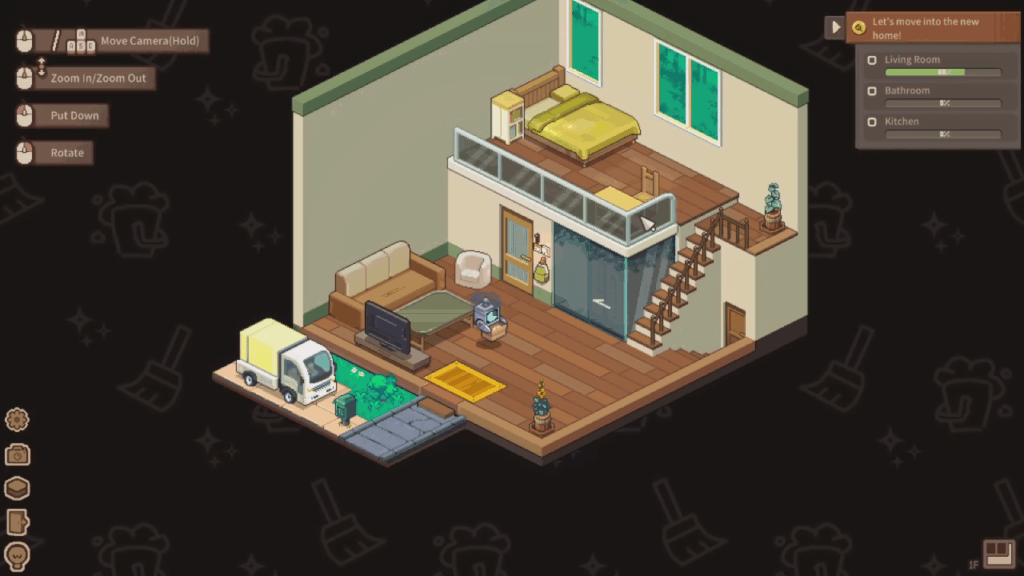
Whisper of the House’s most impressive feature is its setting. Whisper Town is a vast isometric space depicting a bustling city center in dense and colorful pixel art. The city’s scale is underscored by the distance from which it is viewed. The player character and the many nonplayer characters who wander Whisper Town’s streets are tiny. Dozens of them could stand shoulder-to-shoulder to reach from one end of the screen to the other.
Whisper Town is a walkable and friendly city filled with many wide avenues and broad squares. Its eastern border features a beach where sunbathers relax near a lighthouse and a small pier. On the opposite end of town is a park that stretches all the way across the map, mixing pleasant gardens, stone monuments, and basketball courts where people indulge in play. In between are dozens of structures, from impressive towers to modest one- and two-storey buildings.
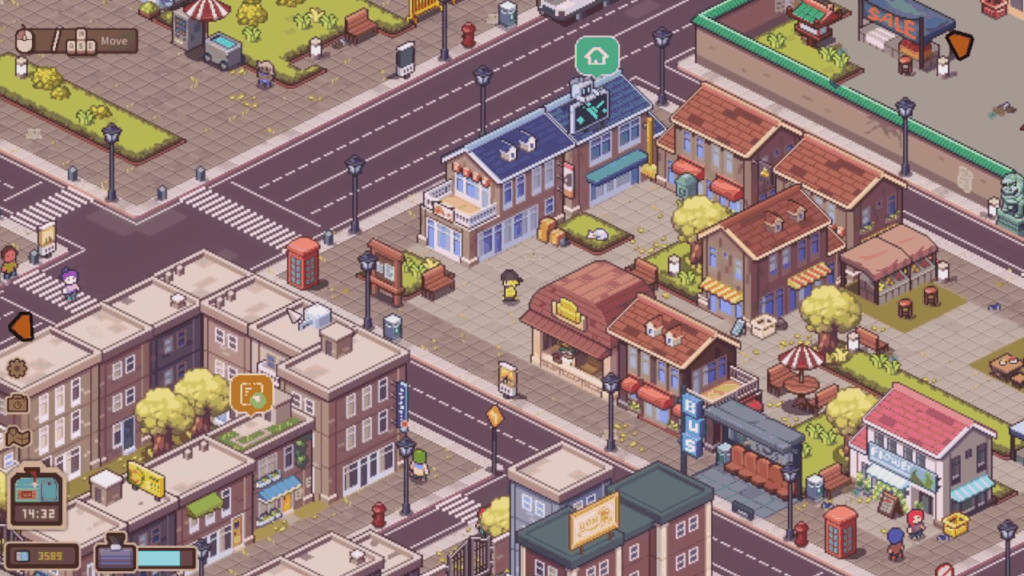
While the player character wanders, time passes at a compressed rate, transitioning from a cheerful day to a cool night punctuated by twinkling lampposts. The shift in time is reflected in subtle shifts in color across the city’s minute pixel art. It impresses no matter where the player character travels.
Though Whisper Town is pleasing to look at and contains a surprising amount to explore, the number of things in it the player character may interact with is much more limited. Only a few buildings may be entered, and then only when the player character is summoned to perform their Housekeeping job. Most of the NPCs who wander purposelessly around town repeat the same few words when spoken to. A few don’t even have their speech translated into English from Whisper of the House’s original Chinese language. Many areas of the city are covered in litter. The player character may pick up discarded papers and will be instantly rewarded with Vouchers, Whisper Town’s currency, or dig around in garbage bins and cardboard boxes to fill his pockets with items like dog poop, empty bottles, and used enemas.
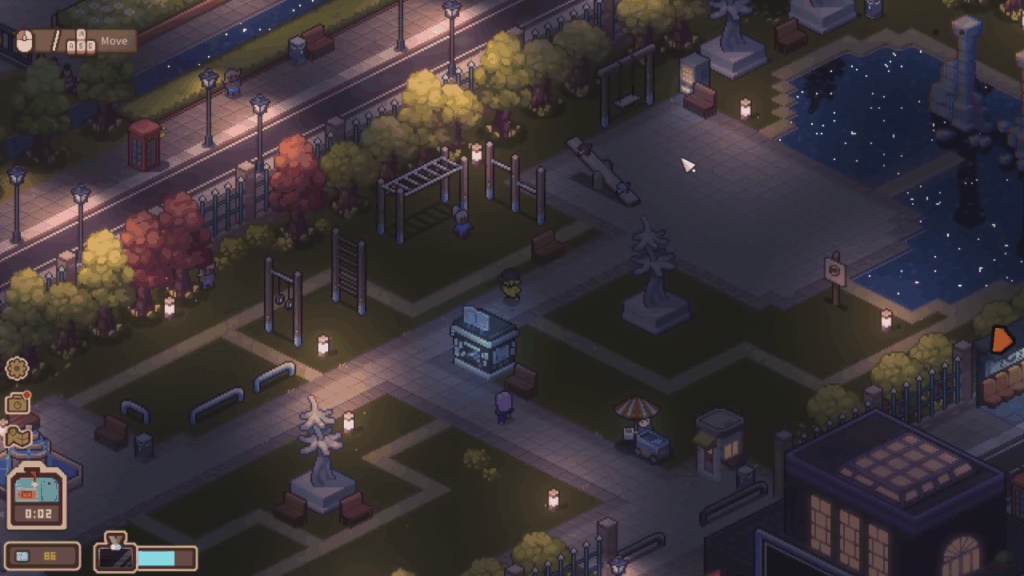
Interacting with Whisper Town moves me rapidly from feeling pleased with its surface presentation to dismayed with the things I am actually able to do there. This abrupt shift is a recurring sensation as I explore the remainder of Whisper of the House’s activities.
The Housekeeping tasks are Whisper of the House’s most structured activities. Whisper Town is filled with residents and merchants who want to unpack and arrange their many possessions into their homes, storefronts, and more unusual spaces. The player character’s job is to respond to requests for help that are delivered to their mailbox on some mornings. Once a letter has been read, I am briefly shown on a map where the job is located and a bright red arrow appears on the screen’s perimeter to guide the player character there. It is difficult to become lost in Whisper Town.
When the player character enters a building, my perspective shifts to its interior. The walls and floors are captured in isometric detail even more incredible than in the city proper. A dialog box has the property’s owner briefly explain their expectations, and then the unpacking begins.
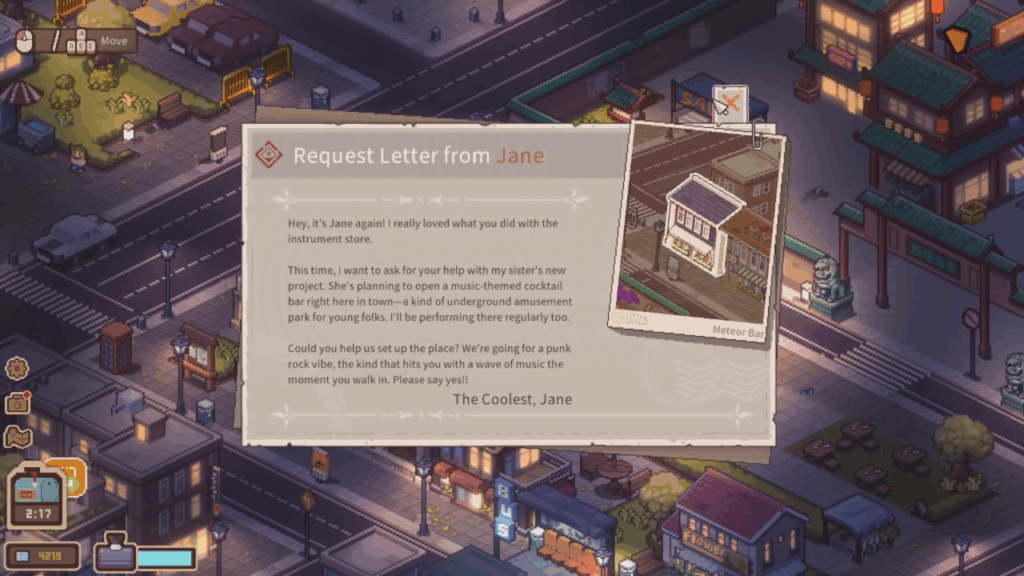
The player character’s companion at each job site is Mark. This robotic moving buddy hovers helpfully in place, holding a box that magically contains every item the client wants moved into the space. Placing furniture and items is as simple as clicking on the box in Mark’s hands, moving the cursor to where I wish the item to go, and clicking again to drop it into place.
There are thousands of potential items of all shapes and sizes that may be pulled from Mark’s moving box, from massive shelves to electronic appliances to hair brushes. Again, Whisper of the House’s pixel art impresses. There’s an admirable variety in furniture styles and colors. Anything that may be pulled from the box can be arranged in at least two isometric angles; many may be viewed from all four. Some objects, like books, can even be toggled between resting upright or on their sides, ensuring they do not look out of place when set on a bookshelf or a tabletop.
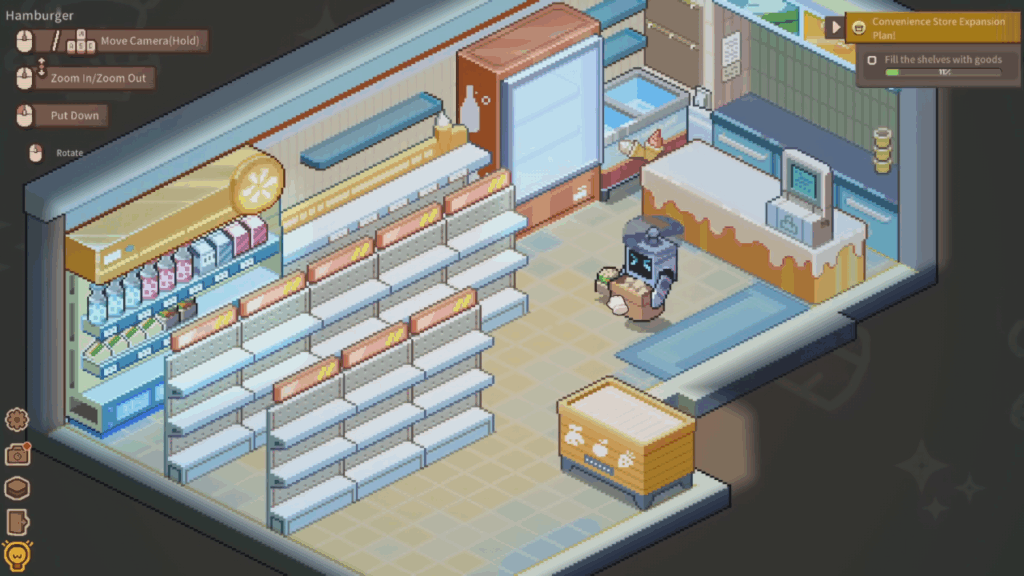
Jobs continue until the player character pulls every object out of Mark’s box and places it in a room. This is the step where Housekeeping becomes wearying. Whisper Town’s residents have an astonishing amount of junk they want the player character to move, especially lots of tiny items like cooking ingredients, candles, and individual shoes. While almost every property includes at least some shelving to place items, furniture with usable drawers and cabinets is surprisingly rare. I begin to despair as the box produces yet another tiny item, see the job’s completion meter is still in the low 70s, and know that there are dozens more items that will need to be dropped on a random tabletop.
The good news is the player character’s clients are not discerning. Whisper of the House has zero capacity to evaluate the livability or usability of anything placed in its properties. Is the TV facing a wall? Is the front door blocked by a heavy chest? Are all of the client’s toiletries strewn across every surface in the kitchen and living room? It doesn’t matter. The player character is still awarded an Excellent rating, an arbitrary number of meaningless points, and gushing praise from the client. In some of the later jobs, my patience exhausted, I begin randomly dropping items anywhere in the space they will fit. The ratings remain the same. It seems impossible to fail.
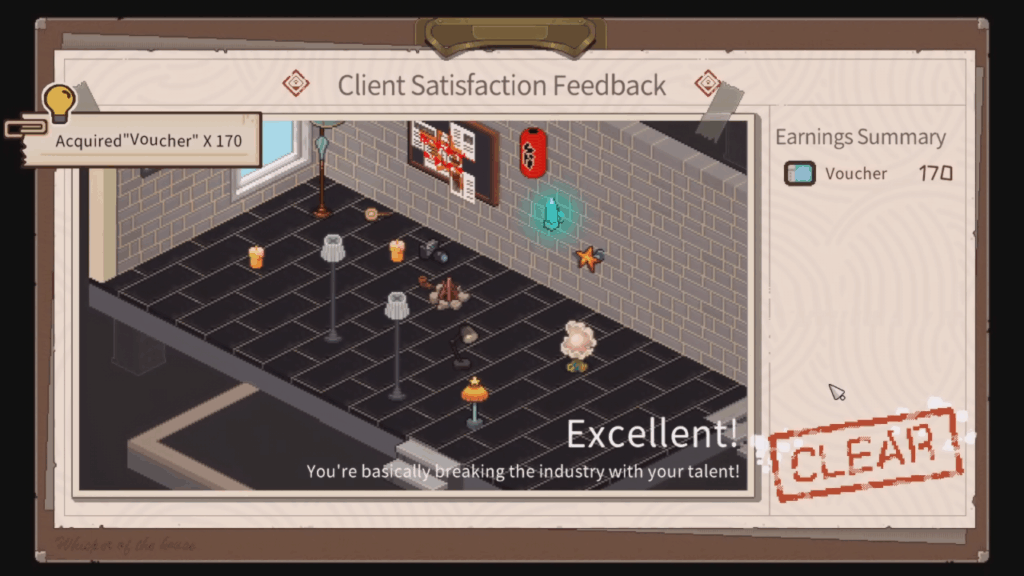
As I near the end of the prebuilt Housekeeping tasks, the player character gains access to a bulletin board that offers additional jobs in exclusive Dream Home Showcase venues dotted around Whisper Town. This is where Whisper of the House tries to create longevity and foster creativity. Four new jobs are randomly created every in-game day, seemingly into perpetuity. The parameters of these jobs are much broader than the structured goals of the main campaign, but also incorporate far fewer objects to be unpacked. After setting out a handful of predetermined pieces of furniture and decoration, the player character may use any other item from their collection to build the meter up to 100% and complete the job.
While the player character adds some furniture pieces to their collection by exploring Whisper Town and completing Housekeeping jobs, their main source of new furniture is shops. Every merchant will exchange some of the player character’s Vouchers for a box of furniture pieces. The pieces the player character receives are random, though the system is weighted to provide at least some new pieces with every box. It doesn’t take long to buy out every merchant’s inventory, and since a piece may be used repeatedly after purchasing it once, there is no need to stockpile my favorite furniture.
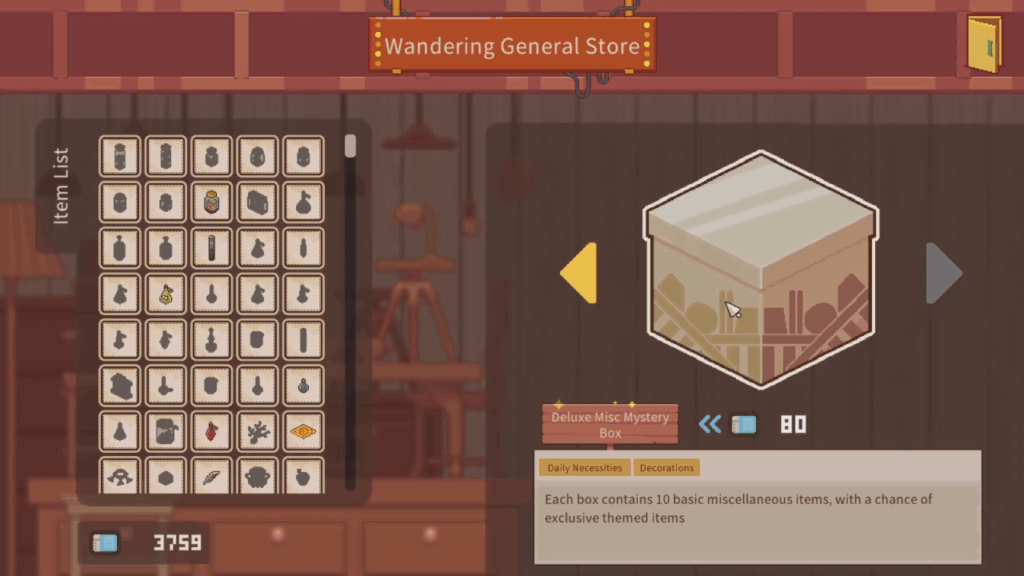
Vouchers are the main reward for completing Housekeeping jobs and they quickly become worthless. Long before the player character has finished all of the Housekeeping jobs, they have bought out every merchant of all their stock, leaving thousands of Vouchers left in their pockets with nothing else to spend them on. The Vouchers and merchant systems may as well not exist at all for what little friction they generate before decorating the player character’s personal house or participating in a Dream Home Showcase.
One of Whisper Town’s most prominent features is a huge pyramid of brick and glass with a holographic display showing the number 42 shining above its entryway. If I steer the player character the few blocks from their house to visit, they find the inside filled with empty displays and a doorway sealed by impassable lasers. Filling these displays and opening the doorway, not completing Housekeeping jobs, is the real goal that will take the player character to the conclusion of their story.
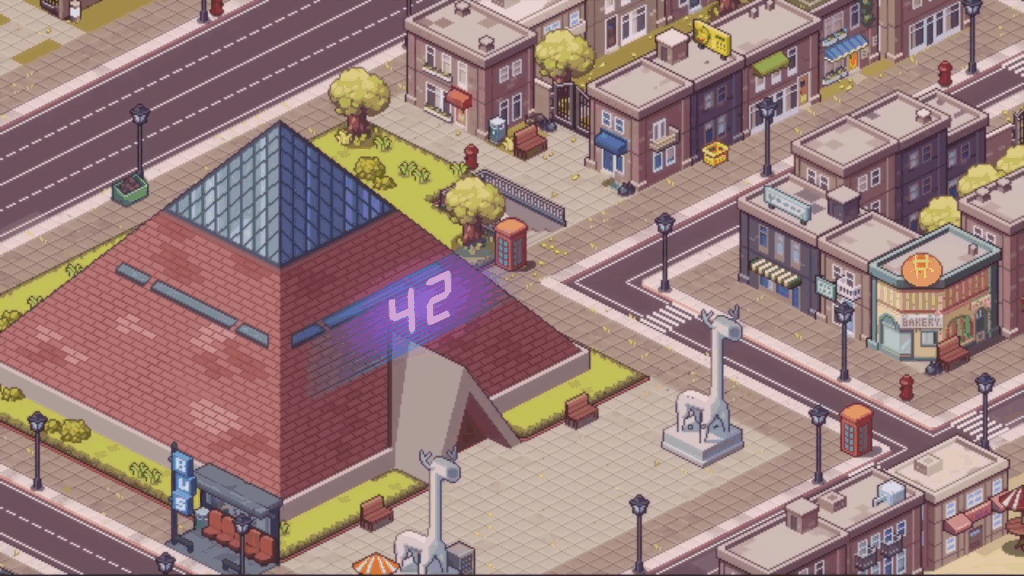
In order to fill in the pyramid’s missing displays, the player character must seek out mysterious phenomenon hidden around Whisper Town. These can take the form of objects, surfaces, and occasionally people, and are immediately recognizable by the ominous symbols and flickering, “glitching” effects that surround them. They may be found inside buildings—which is the only impact completing Housekeeping jobs has on the progression—or throughout Whisper Town’s streets. Finding one of these mysterious objects and clicking on them repeatedly causes the odd effects surrounding them to vanish, realigning the object with Whisper Town’s reality. A copy of the object appears inside the pyramid, and the number above its doorway counts down by one. Only by finding all 42 objects around Whisper Town will the door inside the pyramid open and the ending become accessible.
Not every mysterious object is immediately accessible. To reach some, the player character must first solve a related puzzle. These take the form of more traditional adventure videogame conundrums. In the player character’s very first Housekeeping job, they discover a hidden room inside a young woman’s apartment where a former tenant is squatting. To solve this “mystery,” the player character must use the junk in the hidden room to set a trap that will cause the squatter to reveal themself to the apartment’s owner. I am not privy to the details of this event. I only know the culprit has been caught when the player character receives a newspaper clipping about it in the mail the following day.
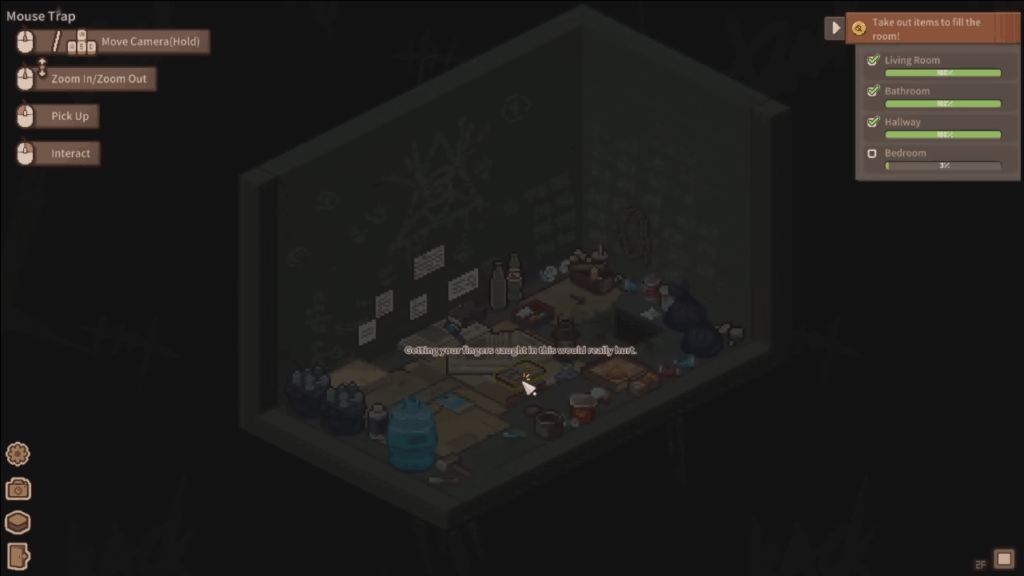
Subsequent puzzles feel like they have been plucked from other, more traditional adventure videogames. While clearing out the house of a man who mysteriously disappeared, the player character finds mystical symbols drawn on the floor next to a cauldron and hand-written notes ripped into pieces. Reassembling the notes allows the player character to repeat his experiments and open a doorway to another dimension. Bricks in a creepy cemetery may be reassembled so the sigil on their surface matches another wall nearby, with spooky results. Not every Housekeeping job has puzzles like this, but the most interesting and memorable ones do.
I confess: I am unable to find all of the mysteries around Whisper Town and open the door inside the pyramid. In contrast to the highly-structured Housekeeping jobs, there is little to guide me to where the cursed phenomenon are hidden. There are only vague hints written in newspaper clippings that arrive in the mailbox and the glowing number above the pyramid door, taunting me with the number of mysteries still left to find.
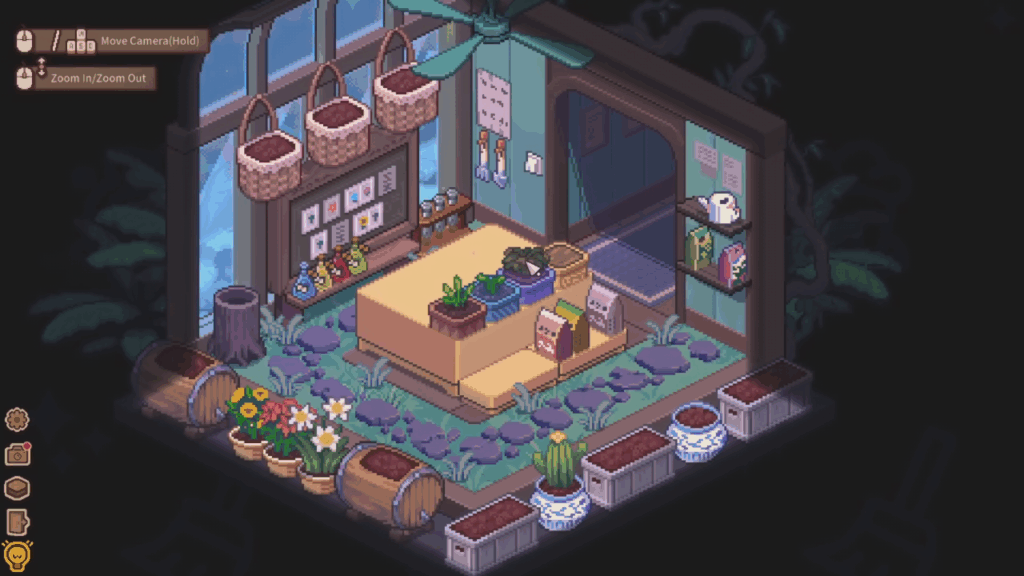
I have strong suspicions of where these mysteries are. One of them is in plain sight. It’s a massive crane in the middle of a construction site, but no matter how many times I steer the player character in circles around the site, they cannot reach the cursed object. The other mysteries are more elusive. Inside a newspaper editor’s home office is an interactable mahjong table. I am certain its tiles must be arranged in some way to make something happen. All the tiles are blank, and I can find no information or diagrams of how I am expected to arrange them. Most frustrating of all is a garden found beneath a flower shop. In a puzzle plucked straight from a LucasArts SCUMM Engine adventure, different seeds, soils, and chemicals may be mixed to cause different plants to grow. No matter how many combinations I try, I always get the same few results, and none of them the ones the chart on the wall expects to be found.
After finishing all the Housekeeping jobs and clicking on every mystery phenomenon I can locate, I spend hours guiding the player character in circles around Whisper Town, searching for more information or something new to do. I get fed up and quit. I don’t do this often. My usual determination to finish every videogame I start is stymied by Whisper of the House’s lack of a hook to draw me into its world and its indifference towards guiding me to its mysteries. Whisper of the House doesn’t seem to care, and so neither do I.
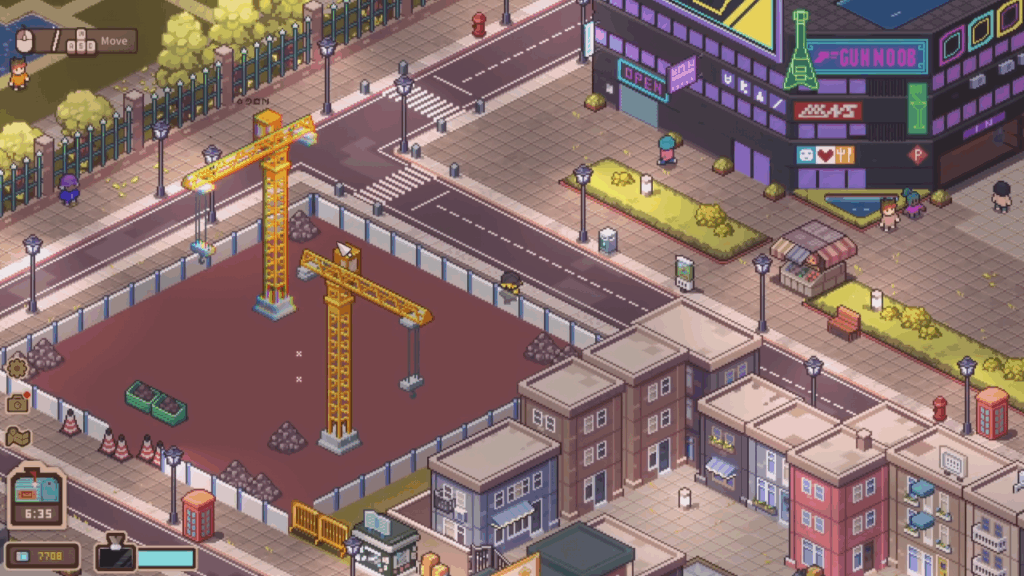
Whisper of the House is like its name: An inaudible sound, dismissed and forgotten as quickly as it is heard. Most of what is here is pilfered from other, better videogames, reused without intention or understanding. Its primary Housekeeping activity is a hollow imitator of Unpacking, devoid of heart and creativity. Its vague, adventure-style puzzles should be its most interesting feature, but the player character is given no compelling reason to seek them out. I’m determined to compliment at least one thing about Whisper of the House, and here it is: Its pixel art graphics are wonderful. The sheer number of objects available to place in houses feels like where the most care went into this videogame’s creation. A videogame needs to do more than look nice to be appealing. At this, Whisper of the House fails in every corner of its beautiful city.